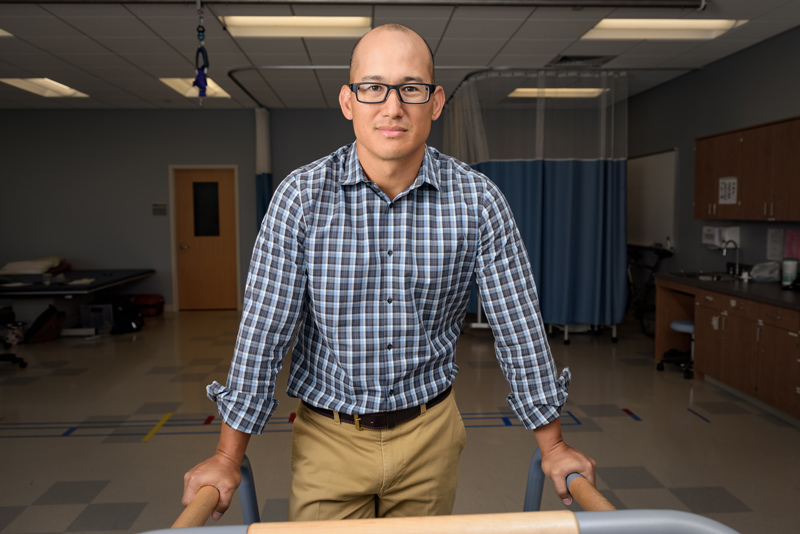


Living with osteoarthritis
Photo by Evan Krape May 17, 2022
UD physical therapy professor dispels myths about exercise and joint pain
Osteoarthritis is the most common form of arthritis that affects more than 30 million Americans nationwide. The condition can make simple daily activities, we all take for granted, like walking and opening jars a challenge.
While evidence shows that staying active can keep knee and joint pain at bay in those who have been diagnosed with osteoarthritis (OA), many believe exercise is harmful and not helpful. Daniel White, associate professor within the College of Health Sciences’ Department of Physical Therapy at the University of Delaware, sought to counter misinformation on that front. White was recently featured on an episode of WebMD’s Health Discovered podcast which focused on joint pain.
“People think that by walking or exercising they’ll damage their knees, and that’s absolutely not true,” White said. “We want to bust those myths. Exercise does not damage your knees. It’s incredibly beneficial for movement, climbing stairs, putting off joint replacement, and reducing overall pain.”
New research from White’s postdoctoral fellow and licensed physical therapist Dana Voinier further aims to bust myths.
“Osteoarthritis, we always think of it as a disease of overloading, but our latest research from Voinier suggests it could be more of a disease of underloading — we’re not loading the joint enough and that is what’s making things worse,” White said.
There’s no magic cure for knee osteoarthritis, which is why White, who also directs UD’s Active Lab, stressed the importance of staying physically active.
“There’s no blockbuster drug, and the benefits of exercise are on the same order as medication as taking an Advil or Tylenol,” White said. “The benefit you get from that is the same, if not greater, with being an active individual.”
Damage to joints from osteoarthritis can’t be reversed, but pain can be managed.
“Take the medication when you have a flare-up or your pain’s worse than usual, but pain overall should come down by adopting an active lifestyle,” White said.
Those who’ve suffered knee injuries earlier in their life, like athletes, are incredibly at risk of developing OA early-on, White said. Weight also remains a major risk factor for OA.
“Maintaining a healthy weight is huge,” White said. “Part of maintaining a healthy weight is being active and finding yourself a sustainable routine that’s also enjoyable to you. When combined with weight loss, the effects of a healthy lifestyle are tremendous.”
For those with OA or at risk of developing OA who aren’t currently physically active, White recommends starting small and getting a device that can monitor steps. White urges people to forget the whole 10,000 steps fad and plug in a new daily step goal into their FitBit or Apple Watch.
“Three-thousand steps per day is a great starting point for a goal,” White said. “Then, build towards 6,000 steps. People who walk 6,000 steps or more are much less likely to develop problems climbing stairs, or walking, or getting out of bed than those who walk less than 6,000 steps.”
The ultimate goal: build up to 150 minutes of moderate exercise a week.
He recommended short walks in the morning or evening, or one longer walk as ways to fit in more steps. But getting those steps in doesn’t have to equate to an exercise obligation. White urges people to make physical activity a social experience that works within a person’s daily life.
“It’s more sustainable to make it a social thing — go to lunch with your friend and walk afterward or before. If you have a sporting event for your child, find a nearby walking path you can use during halftime,” White said. “If the weather’s bad, it’s always a sunny day inside Christiana Mall.”
Walking indoors on a treadmill is also an option, and White sought to dispel myths that treadmills are harder on the knees.
“A study in those who had knee osteoarthritis found there was no difference in the rate of progression of the disease among those people who did nothing compared to those people who were in exercise condition,” White said. “So, you’re not going to accelerate damage to your knee by doing more and that includes walking either outside or on a treadmill. So don’t worry about hurting your knees or making things worse by walking.”
Other easy tips to get more steps in include taking the stairs instead of the elevator or parking farther away from a person’s destination. Swimming or cycling are also strong options, but no matter the type of physical activity, building up a sweat is key.
“Whatever you enjoy doing, ideally with friends, has a much higher likelihood of success than going at it alone,” he said.
The Department of Physical Therapy at the College of Health Sciences has been ranked No. 1 in the nation by U.S. News & World Report. White urged people living with osteoarthritis who are in pain to seek help at the state-of-the-art Physical Therapy Clinic.
“For those who may be a little nervous about starting an exercise regimen or are unsure what to do and what not to do, the clinic is open and readily accepting new patients,” he said. “We have the top therapists in the country treating at this clinic, and it’s a really great opportunity for our Delaware community to take advantage of that.”
Contact Us
Have a UDaily story idea?
Contact us at ocm@udel.edu
Members of the press
Contact us at 302-831-NEWS or visit the Media Relations website

